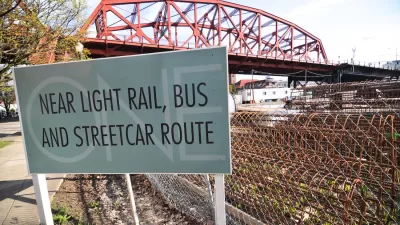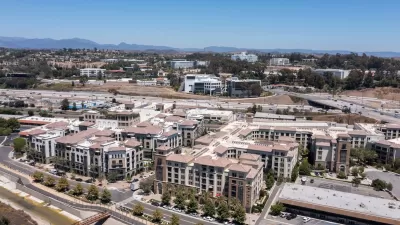As many planners know, building next to transit doesn't guarantee a project will have the ridership boosting effects envisioned by proponents of such developments. A new tool seeks to provide an objective measurement of TOD effectiveness.

"[P]lanners have invested decades of considerable work in the pursuit of transit-oriented development (TOD), under the presumption that clustering new housing, offices, and retail will result in rising transit use and, in turn, reduce pollution, cut down on congestion, and improve quality of life," writes Yonah Freemark. Yet, he continues, "what has been missing has been a tool that offers empirical insight into the benefits of specific development interventions in terms of their effect on growing transit use."
"To fill the gap, a new tool for measuring TOD quality has recently been introduced by the Institute for Transportation and Development Policy (ITDP). It holds potential value in terms of defining the appropriate measures for creating effective TOD, but it needs further development to be useful in aiding the creation of best-practice development designs."
Freemark tests the tool's effectiveness by applying it to three large TOD projects; and offers some insights into its potential benefits and current failings.
FULL STORY: Defining Clear Standards for Transit-Oriented Development

Manufactured Crisis: Losing the Nation’s Largest Source of Unsubsidized Affordable Housing
Manufactured housing communities have long been an affordable housing option for millions of people living in the U.S., but that affordability is disappearing rapidly. How did we get here?

Americans May Be Stuck — But Why?
Americans are moving a lot less than they once did, and that is a problem. While Yoni Applebaum, in his highly-publicized article Stuck, gets the reasons badly wrong, it's still important to ask: why are we moving so much less than before?

Using Old Oil and Gas Wells for Green Energy Storage
Penn State researchers have found that repurposing abandoned oil and gas wells for geothermal-assisted compressed-air energy storage can boost efficiency, reduce environmental risks, and support clean energy and job transitions.

Greening Oakland’s School Grounds
With help from community partners like the Trust for Public Land, Oakland Unified School District is turning barren, asphalt-covered schoolyards into vibrant, green spaces that support outdoor learning, play, and student well-being.

California Governor Suspends CEQA Reviews for Utilities in Fire Areas
Utility restoration efforts in areas affected by the January wildfires in Los Angeles will be exempt from environmental regulations to speed up the rebuilding of essential infrastructure.

Native American Communities Prepare to Lead on Environmental Stewardship
In the face of federal threats to public lands and conservation efforts, indigenous groups continue to model nature-centered conservation efforts.
Urban Design for Planners 1: Software Tools
This six-course series explores essential urban design concepts using open source software and equips planners with the tools they need to participate fully in the urban design process.
Planning for Universal Design
Learn the tools for implementing Universal Design in planning regulations.
Heyer Gruel & Associates PA
City of Moreno Valley
Institute for Housing and Urban Development Studies (IHS)
City of Grandview
Harvard GSD Executive Education
Salt Lake City
NYU Wagner Graduate School of Public Service
City of Cambridge, Maryland




























